July 6, 2007
Air Date: July 6, 2007
FULL SHOW
SEGMENTS
The Problem with Perchlorate
View the page for this story
A new study from the Centers for Disease Control suggests that long term exposure to low levels of the chemical perchlorate may be hazardous to health, especially to women of childbearing age and children. Host Steve Curwood speaks with Dr. Richard Jackson, a former director at the CDC and professor of environmental health sciences at UC Berkeley. (05:30)
Navigating Masculinity
View the page for this story
There is a growing body of scientific evidence linking men’s exposure to environmental toxins, such as cigarette smoke or herbicides, to reproductive health problems, and the health of their children. But society and the scientific world alike have been hesitant to accept the evidence, argues Cynthia Daniels in her book, “Exposing Men: The Science and Politics of Male Reproduction.” Daniels is an associate professor of Political Science at Rutgers University and speaks with host Steve Curwood. (06:30)
From Ashes to Bricks
/ Daniel KrackerView the page for this story
Even with the closure of the Mojave power plant, coal and coal waste are a major economic force in Navajo country. And as Daniel Kracker reports from Arizona, Navajos have found a new way to use coal plant waste from another power plant. They're making a new kind of concrete that could help solve the reservation's acute housing shortage. (07:00)
Chasing Kangaroos
View the page for this story
Yes Virginia, there are, in fact, ten different kinds of tree kangaroos. Author Sy Montgomery traveled with scientist Lisa Dabek to the ancient cloud forest of Papua New Guinea in search of the Matschie’s Tree Kangaroo. They get up close and personal with this tree-hugging marsupial in the new children’s book “Quest for the Tree Kangaroo" (08:30)
Emerging Science Note/Virtual Detective
/ Ian GrayView the page for this story
A new computer program separates fact from opinion in texts. Ian Gray reports. (01:30)
Fishing With Hoagy
/ Bob CartyView the page for this story
The Grand Cascapedia River, on the Atlantic coast of Canada, boasts some of the best sport fishing in the world. Its salmon stocks are in great shape and people pay big money for permits to fish there. Hoagy Bix Carmichael, son of the singer-songwriter of the same name, fell in the love with the Cascapedia River. Carmichael took producer Bob Carty fly fishing and talks about the river's unusual history and of concerns for its future. (15:45)
This week's EarthEar selection
listen /
download
A fledgling bald eagle goes fishing for dinner
Show Credits and Funders
Show Transcript
HOST: Steve Curwood
GUEST: Dr. Richard Jackson, Dr. Cynthia Daniels, Lisa Dabek, Sy Montgomery
REPORTER: Daniel Kraker, Bob Carty
SCIENCE NOTE: Ian Gray
[THEME]
CURWOOD: From Public Radio International - this is Living on Earth.
[THEME]
CURWOOD: I’m Steve Curwood. The rocket fuel perchlorate is in the water supply of dozens of states. Now a study from the Centers for Disease Control suggests the pollution may have put millions of women and their children at risk of thyroid disease.
JACKSON: I was surprised. I really did not think we would find in a population that such low levels were having measurable impacts on people’s health. I think it’s a real eye-opener about what some of these, we think are very small levels of chemicals in the environment and what they can do to us.
CURWOOD: Also, the Grand Cascapedia River in eastern Canada boasts some of the largest salmon in North America. The son of a famous singer songwriter is hooked on the river and its unusual history.
CARMICHAEL: I loved the beauty of the river, seeing a bald eagle land as I was casting for a rising 20 lb salmon.
CURWOOD: Fishing with Hoagy this week on Living on Earth. Stick around!
[MUSIC]
[NPR NEWSCAST]
ANNOUNCER: Support for Living on Earth comes from the National Science Foundation and Stonyfield Farm.
[THEME]
The Problem with Perchlorate

In 2005, perchlorate was found to contaminate drinking water in 26 states, according to the EPA. (Photo courtesy of STI/NASA)
CURWOOD: From the Jennifer and Ted Stanley Studios in Somerville, Massachusetts - this is an encore edition of Living on Earth. I’m Steve Curwood. A major study by the U.S. Centers for Disease Control has concluded that trace amounts of the rocket fuel perchlorate found in drinking water, milk and produce, may be endangering the health of millions of women and their children with thyroid disease.
The CDC study, begun in 2001, looked at nearly 3,000 Americans and found health effects at “exposure levels unanticipated” by previous research. The findings are sure to fuel an ongoing controversy among regulators about safe levels of exposure to perchlorate, a persistent pollutant which is found in the groundwater of more than two dozen states. To find out more, we turn now to pediatrician Richard Jackson, professor of Public Health at UC Berkeley, who is a past director of the CDC’s Environmental Health Unit.
Hello Sir!
JACKSON: Hi Steve, it’s a pleasure to be with you.
CURWOOD: So doctor how surprised were you by these results?
JACKSON: I was surprised. I really did not think we would find in a population that such low levels were having measurable impacts on people’s health. I was always taught that the higher levels have the impact. This is kind of a gold standard study. You have the best laboratory in the world for doing biomonitoring looking at a robust sample of the American people and coming up with findings that have been peer reviewed extensively and I think will hold up to scrutiny anywhere.
CURWOOD: Now, Dr. Jackson, first tell me why are women the risk group here and not men? What’s different about women’s body composition that makes them a vulnerable population to something like this?
JACKSON: Well you know we all need iodine in our diet. But women in particular because of pregnancy needs and others, need some more. In fact they need to be taking vitamins when they’re pregnant. Iodine is important as an adult. It helps you make thyroid hormone. Your energy levels are related to it. But it’s particularly important to infants to the fetus for its development. In fact if a baby is born without enough iodine or thyroid hormone on board they can be left permanently damaged. So it’s really this reproductive age that we are most worried about.

In 2005, perchlorate was found to contaminate drinking water in 26 states, according to the EPA.(Photo courtesy of STI/NASA)
CURWOOD: Now what’s the connection between perchlorate and iodine and thyroid problems in humans?
JACKSON: Well, we’ve known for a long time that we can use perchlorate to treat people with hyperactive thyroids and it will suppress thyroid’s putting out of hormones. What we didn’t know is would low doses of perchlorate suppress the thyroid’s functioning. And it looks at least from this study, and it’s just one study that, particularly in women with low iodine levels, it is having an effect on the thyroid.
CURWOOD: So how many women have relatively low iodine levels or thyroid problems?
JACKSON: We guess that about a third of the population of women ought to be getting more iodine in their diets. In fact we’ve been noticing one of the reason CDC does these studies is actually in the beginning is to profile the nutritional level of people in the United States. Over the last 30 years iodine levels in the US population have been dropping.
CURWOOD: You’re a physician, a pediatrician, for somebody who’s listening who’s concerned, particularly a women of reproductive age who’s concerned about this, what precautions might she take.
JACKSON: I think one as a public health doctor, I’m pretty passionate that tap water ought to be safe and everyone ought to be able to drink it. You shouldn’t have to go to bottled water and other sources. So demanding that your water suppliers are providing water within the standards and demanding the standards come into compliance with up to date science is important, number one. Number two it is important to get enough iodine in our diets. About half a teaspoon of iodized salt a day will give you enough to get by just fine. Thirdly, women who are pregnant need to be taking their vitamins for folic acid and lots of other and calcium and lots of other reasons as well. So those would be three things I would do.
CURWOOD: How does perchlorate end up in our ground water supply? Who’s responsible?
JACKSON: Much of the perchlorate that’s in water is a byproduct of various industrial processes. It’s quite a durable molecule. It stays in the water for long periods of time and it actually can get in to food products if that water is used for irrigation. So we’re finding perchlorate in many food products, lettuce and other vegetables that are irrigated with this water as well as finding it in the water its self.
CURWOOD: Now there’s been quite a bit of controversy over the acceptable groundwater levels of perchlorate. What do you think the impact of the CDC study on perchlorate will be?
JACKSON: One: it shows the importance of biomonitoring. When I was learning toxicology we were told well the very low doses don’t matter. It’s really the large doses that create the poisonous effect. What we’re learning from these biomonitoring studies, where large numbers of people are examined for very small levels of these chemicals and then look to see the interaction with genes or other exposures and the rest. We’re learning really kind of surprising information. I was surprised that they found such a robust finding in the CDC study at this level. As the academy of sciences sits down and weighs all this information I suspect they’re going to, if all this holds up in subsequent studies, they’re going to recommend a more stringent level. But the bottom line is it needs to be an open scientific process up front and an open management process that’s understandable once we go into setting an actual standard.
CURWOOD: Dr. Richard Jackson is a professor of environmental health sciences and the former director of the Center for Disease Control’s National Center for Environmental Health. Thank you so much Dr. Jackson.
JACKSON: My pleasure Steve, thank you.
Related link:
Centers for Disease Control Study on Perchlorate
Navigating Masculinity

Author Cynthia R. Daniels (Photo: Katherine Daniels)
CURWOOD: While much of the research on environmental hazards and reproductive health focuses on women, more and more research shows that men also run special risks.
Perhaps the most attention has been paid to men who were exposed to the defoliant Agent Orange while they were soldiers in Vietnam. Back home, many of them fathered children with birth defects such as cerebral palsy and Spina Bifida. But as scientists have uncovered more evidence of the havoc toxic exposure can wreak on male reproductive health, little has been said about it. Cynthia Daniels hopes to change that. She has written a book entitled “Exposing Men, the Science and Politics of Male Reproduction.”
Professor Daniels teaches Political Science at Rutgers University. Professor Daniels, hello.
DANIELS: Hello, thanks for having me.
CURWOOD: So, you’re a political scientist. What got you on to the subject of male reproductive health?
DANIELS: Well, in my previous work I had examined female reproductive health and female reproductive politics. Looking primarily at the criminal prosecution of women who had used drugs or alcohol during their pregnancy and then were criminally prosecuted for child abuse or delivering drugs to the fetus through the umbilical cord. In the course of doing that work I came across quite a substantial body of scientific research that indicated that men’s use of drugs and alcohol or men’s exposure to toxic substances could also produce harm in the children that they fathered. Increased rates of birth defects, increased rates of miscarriage. And so I was a little stunned by the fact that there was no public attention to this growing body of scientific evidence.
CURWOOD: Now you say historically the singular focus of reproductive medicine on the female reproductive system was paralleled by concurrent neglect of the male system, I’m quoting from your book here. Why do you think that women get so much more attention when it comes to reproductive health?
DANIELS: Well, women have historically been the property of men. So, I think we are looking at the historical vestige of the idea that we have a greater right to regulate and control the female reproductive body than the male reproductive body. And I think we still operate with this reproductive sexual division of labor where we see women as primary, it’s a cultural assumption that women have the primary responsibility for producing healthy children and caring for healthy children. And that men are really much more distant. So I think that has to do with what I see as outdated cultural assumptions about men and women’s different and disproportionate relationship to human reproduction.
CURWOOD: Perhaps as many as maybe about 15 years ago there was a lot of publicity about some research in Denmark showing that male sperm counts had dropped to, oh, maybe half of their previous levels from samples that had been taken I guess, back in the 1930’s. What was the public response to those findings and that publicity?
DANIELS: Oh, there were hundreds of magazine stories and newspaper stories about the sperm count drop. Many of them with pretty sensationalist titles like, “Sperm under Siege” and “Sperm Wars.” Many of them predicting, you know, doom and the end of the earth. It became a metaphor for what many saw as a crisis of masculinity.
CURWOOD: When these results come out the group in Denmark led by I believe it was Nils Skakkebaek and others came under tremendous attack. Why was this research group so questioned by the scientific and industrial community?
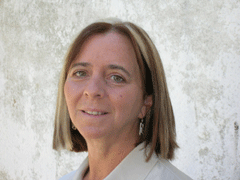
Author Cynthia R. Daniels (Photo: Katherine Daniels)
CURWOOD: So as a political scientist, where do you think we need to make changes in this society to deal with what you identify as a really serious crisis in male reproduction?
DANIELS: You know, we need to start asking the right questions. We need to start asking questions about men’s relationship to conception, to pregnancy, to childcare, child bearing. For instance the study that you had on air about the association of ADHD with cigarette smoking and lead exposure. You know, I looked at that study and there were no questions asked about paternal cigarette smoking. Now how hard would it be in a study like that to ask the women not just about their own use of cigarettes but about paternal cigarette smoking. We’re not even asking the questions. Also that study indicated that there are higher rates of ADHD for baby boys, for boy children. Why then are we not asking questions about whether the male body is somehow more vulnerable to harm from lead than the female body? We seem to not want to even ask those questions.
CURWOOD: Cynthia Daniels is an associate professor of political science at Rutgers University. Her new book is called, “Exposing Men; the Science and Politics of Male Reproduction.” Thank you.
DANIELS: Thanks for having me.
Related link:
“Exposing Men” by Cynthia Daniels
CURWOOD: Coming up: turning coal waste to bricks may help solve a Navajo housing shortage. Stay tuned to Living on Earth.
From Ashes to Bricks
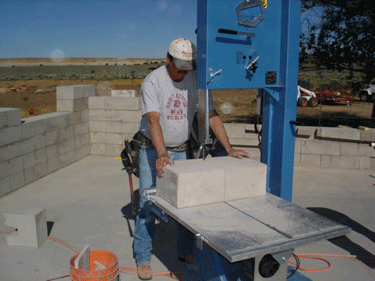
This home, built with flexcrete blocks, will be fireproof and wind-tested to 200 mph. (Photo: Gary Damron)
CURWOOD: It’s Living on Earth. I’m Steve Curwood. The place where the states of Arizona, Utah, Colorado and New Mexico meet is called the Four Corners region. And thousands of Navaho families live there in overcrowded, dilapidated buildings and trailers, often without running water or electricity. Many have waited for new homes — either from the federal or tribal government — for more than a decade. Now the tribe has a state-of-the-art facility that turns waste from burned coal into a new generation of building materials. As Daniel Kraker of Arizona Public Radio reports, the Navajo hope it will help solve their housing crisis.
[SOUND OF POWER PLANT]
KRAKER: Coal-fired power plants like the Navajo Generating Station just outside Page, Arizona, create 125 million tons of ash every year. A little more than half that is fly ash, the finest and lightest ash that would fly out the smokestack if it wasn’t captured. But at this enormous plant, environmental engineer Paul Ostapuk says a half million tons of fly ash are collected annually from the combustion airstream.
OSTAPUK: There’s 16 chambers, six electrical fields in each chamber. We charge the fly ash particles, they’re attracted then to electrical curtains, and we rap on those curtains and collect the fly ash down in hoppers.
[RAPPING SOUND]
OSTAPUK: So, that’s rapping.
[TRUCK SOUND]
KRAKER: Nationwide, about 60 percent of fly ash collected at power plants is landfilled or re-buried in the coal mines it came from.
[PASSING TRUCKS]

This home, built with flexcrete blocks, will be fireproof and wind-tested to 200 mph. (Photo: Gary Damron)
KRAKER: But that’s not the case at the Navajo Generating Station. Nearly all of the fly ash created here is trucked three miles down the highway to manufacture a unique new building material called flex-crete.
[PLANT SOUND]
KRAKER: Gary Damron manages the plant, which is owned by the Navajo Nation.
DAMRON: Right now, 40 percent of our mixture ratio is fly ash, so it’s a very large proportion.
KRAKER: The ingredients are mixed together and placed in a 20 foot long mold where millions of microscopic gas bubbles cause it to rise like a giant loaf of bread to about twice its height. It takes about two days for it to harden or cure.
[SAWING SOUND]
KRAKER: Then it’s sawed into bricks that look like traditional cinder blocks, but Damron says are more like an ideal combination between concrete and lumber. Though he says that makes some customers skeptical.
DAMRON: They’re like, ‘okay, we hear all the benefits.’ You know, it’s easy to work with, it’s a solid material, it has a very high R value as far as your heating and cooling requirements, it’s fire resistant, it creates a noise barrier. And they always say, ‘okay, tell me what’s wrong with it.’ Being that it’s a porous material, you do have to seal it. It’s susceptible to moisture if it’s left in a raw state; besides that, I don’t think there is a holdback to flex-crete.
KRAKER: Flex-crete is one of several building products known as aerated, or cellular, concrete that replace a portion of their cement with fly ash. The technology has existed for about 70 years in Europe, and more recently in this country. But Damron says flex-crete is the first concrete developed that doesn’t need to be autoclaved – essentially, cured in a giant pressure cooker.
DAMRON: To achieve the same thing we would achieve with flex-crete would cost this plant an additional 15 to 20 times more if we had to initiate an autoclave, and we would consume a large portion of energy to create the same thing.
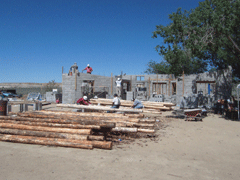
(Courtesy of the ASU Stardust Center for Affordable Homes and the Family.)
KRAKER: Flex-crete, as well as other aerated concretes with names like e-crete and safe-crete, offer another environmental bonus. That’s because they use fly ash to replace cement. For every ton of cement produced, one ton of carbon dioxide is released into the atmosphere.
These new products, though, have been developed against the backdrop of a fierce disagreement over fly ash. The coal industry considers it a benign byproduct. Environmentalists, like Lisa Evans with the Clean Air Task Force, believe the ash, at least in its powdery form, is hazardous.
EVANS: Like the coal it came from, fly ash contains numerous heavy metals and other toxic substances, such as arsenic, chromium, lead, mercury, selenium, boron and more, and when the ash comes into contact with water, these hazardous substances leech out of the coal ash and enter the environment, sometimes in quantities, or often quantities, that are harmful to health and the environment.
KRAKER: But the EPA says fly ash is not a hazardous waste. As a result, it’s up to the states to regulate its disposal. The results have been uneven. A landfill leak in Indiana and a coal ash landslide in Pennsylvania have contaminated drinking water supplies. Evans says stricter disposal regulations would spur utilities to find more ways to reuse fly ash.
[SOUND OF PUMPING WATER AND PEOPLE TALKING ]
AUGUSTINE: It’s going to work for me…
[PUMPING]
KRAKER: In the northeast corner of the Navajo Nation, 73-year-old Mary Augustine tries out the water pump in front of her brand new home, the first on the reservation built with flex-crete. Mary and her husband Kee had been on a waiting list for a new home for years. Their old house had only one electrical outlet and a leaky roof. Now, Mary says, they’ll be able to stay here in this wide sandstone canyon dotted with cottonwoods.

The original Augustine residene that was demolished and replaced (left photo). Mary and Key Augustine's new home (right). (Photos courtesy of the ASU Stardust Center for Affordable Homes and the Family.)
KRAKER: That’s the TV show that rebuilds houses. This home, though, was built by the Navajo Housing Authority and designed by the Stardust Center for Affordable Housing at Arizona State University.
[DOOR OPENING]
KRAKER: Daniel Glenn, the center’s co-director, opens a door into the home’s entryway.
[DOOR CLOSES]
KRAKER: Inside it’s cool, despite the hot late summer sun. Glenn says he had planned to use straw bales, until he learned that flex-crete made a thicker 12 inch block.
GLENN: The disadvantage of straw bale is it’s not a good mass. It’s good insulator but not a good mass; in hot climates you need mass to absorb the heat. And so the 12-inch thick mass wall behaves extraordinarily well in this high desert climate.
KRAKER: That’s what the Navajo Housing Authority is banking on. The NHA financed the construction of the flex-crete plant in Page and has a 10 percent ownership stake in the technology. The Navajo Authority hopes its new, cheaper building product will help put a dent in the estimated 60,000 new homes needed across the reservation. For Living on Earth, I’m Daniel Kraker on the Navajo Nation.
Related link:
Stardust Center for Affordable Homes and the Family
Chasing Kangaroos

A tree kangaroo at home in the Cloud Forest in Papua, New Guinea. (Photo: Nic Bishop)
CURWOOD: If you were to look up in a tree and see a kangaroo, you might jump out of your skin in surprise. What’s a kangaroo doing in a tree? Well, if it’s a tree kangaroo, it’s probably making itself right at home. Not much is known about the elusive tree kangaroo, but scientist Lisa Dabek hopes to change that.
She’s been researching these teddy bear-like tree climbers and working to conserve the ancient forests of Papua New Guinea that one species of these high altitude marsupials calls “home.” On her last field expedition, Lisa Dabek brought along author Sy Montgomery. Sy wrote a children’s book about their adventure called “Quest for the Tree Kangaroo.”
Sy and Lisa, welcome to Living on Earth.
MONTGOMERY: Thanks for having us.
DABEK: Thank you, it’s great to be here.
CURWOOD: So, Sy, what’s a tree kangaroo look like?
MONTGOMERY: Oh my gosh. It looks like something that Dr. Seuss would have made up if he was working with a manufacturer of stuffed toys.
CURWOOD: (laughs)
MONTGOMERY: It is just the most adorable thing you’ve ever seen. And it has these pert upright ears. It has a white snout with a lovely little pink nose. It has a long golden tail. And it has a lemon yellow or white belly and great big sweet eyes. Unbelievably cute. And it’s about the size of a great big raccoon.
CURWOOD: Sy, when you first went into the cloud forest where these tree kangaroos are at home, what was it like? What did you see? What is one of these cloud forests like?
MONTGOMERY: Oh, man. It’s a gorgeous, gorgeous place. I like to tell people it’s like what heaven would look like if heaven had leaches.

Tree Kangaroos have been known to jump down 85 feet from their lofty perches in the cloud forest. (Photo: © Nic Bishop)
MONTGOMERY: And who knows, maybe they do. First of all to get there this is the most remote place I’ve ever been in my life of all the expeditions I’ve ever done. We had to hike for three days up into the cloud forest, up to 10,000 feet, where the forest is just shrouded in mist. It feels like a mystical magical place. And all the great trees are covered in moss. And the moss is laced with ferns and there’s great big vines hanging from everything, thick with moss. There’s orchids growing out of the trees. There’s rhododendrons growing out of the trees. Some of the flowers are huge and showy and some of them are small as a dress maker’s pin. And it looks just like the kind of place where you’d expect some hobbit or a troll to step out. But better than that, look who’s there: kangaroos in the trees.
CURWOOD: Now Lisa, these guys are hard to see, let alone monitor or track. What do we know about tree kangaroos? And what have you learned in studying them?
DABEK: Well, what we do know is that they are kangaroos. They are in the kangaroo family. They have pouches like regular kangaroos. But they live in the trees. And really nothing was known about them but from the work that we’ve been doing in Papua New Guinea we now know how they use the forest, how much forest they need to eat and to move around, to find their mates. We’re learning a lot of different things.
CURWOOD: Lisa how do you catch an animal that’s hard to see? And looking at the book that you guys put together, the photographs, seems to be perfectly happy at 85 feet up in the air.
DABEK: I know, it’s amazing. The villagers, the hunters, spot them. And then they cut down the brush underneath the tree. And they surround the tree. And then one of the men climbs a neighboring tree and starts making noise to frighten the animal. And the animal, when it wants to get away, it can leap down as far as 80 feet. And once the animal lands on the ground the hunters can grab the tail of the animal.
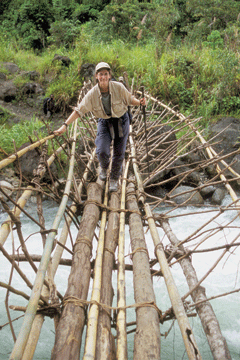
Lisa Dabek on her way to the Cloud Forest. (Photo: © Nic Bishop)
DABEK: I would not be able to do that.
CURWOOD: Now, you get the locals to help you catch them. And then what do you do once you’ve got a tree kangaroo?
DABEK: Well, we have a team of researchers and we take blood samples and measurements of the animals. And then we put radio collars on them to really get a good handle on the home range of the animals because that’s going to determine how much forest we really need to protect for healthy populations of animals. And then we’re also trying to get a good handle on their feeding ecology. So far we’ve documented that they eat over 90 species of plants. So we put the radio collars on but we’re also, these blood samples and fecal samples we’re able to look at the genetics of tree kangaroos. And that’s really important because very little is known about the taxonomy and classification of tree kangaroos. There was a new tree kangaroo species that was discovered in 1995, so only ten years ago. And for a large mammal that’s pretty exciting.
CURWOOD: Now, Sy, from your visit there how do the people in New Guinea view the tree kangaroos?
MONTGOMERY: Well, they think until Lisa told them, that everyone has tree kangaroos. That’s why they thought she was kind of nutty to want to see them. And they were thrilled to discover that they were the lucky ones, the only people in the world to have the species that Lisa studies, the Matchies, it only lives on one peninsula on one half of this one island in the whole world.
CURWOOD: Animals like this often have some folklore about them. What’s something special that folks there believe maybe a myth about the tree kangaroo?
MONTGOMERY: Well, they obviously think that tree kangaroos have some special power, because there’s one belief that if you think of the girl that you love before you let your arrow fly to shoot a tree kangaroo, at the moment the arrow pierces the animal’s body that’s when she will fall madly in love with you.
CURWOOD: Oh, my. That makes it tough on the tree kangaroos.
MONTGOMERY: Yeah, I know. It’s really a pretty rotten Valentine’s Day gift for them.
[LAUGHS]
CURWOOD: Lisa, what are the major challenges facing the tree kangaroo in terms of conservation?
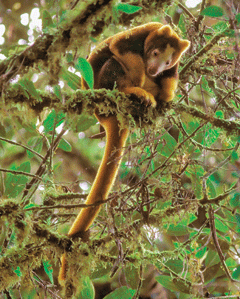
A tree kangaroo at home in the Cloud Forest in Papua, New Guinea. (Photo: © Nic Bishop)
CURWOOD: What do you hope this book accomplishes, Sy?
MONTGOMERY: Well, a couple of things. First it’s a great adventure story about real science. This is like a National Geographic expedition. You know 44 people from three continents including quite a few local people hiking for three days to a totally unknown place to study an animal about which almost nothing is known. That’s just a great adventure story that makes science exciting to kids. And Lisa’s a great heroin. I mean she’s a fabulous scientist and a thing that few people know, but will after they read this book about her is that even though she’s working at ten thousand feet in this very strenuous environment, she has asthma and she has not let that stop her. She also didn’t let it stop her when other scientists said that what she wanted to do would never work. So that’s a great lesson for kids.
Another thing, because she’s amassed this large team of people from all over the world, some of us bring to this job talents you wouldn’t think could help conservation. So whatever talent you have you can bring this to help the world remain whole. But the one thing of course that I really want to get across the most, and you know this Steve, is that all of my books are really love stories. And these animals, you just look at them and immediately you just loose your heart. You love them. You can not help but want to know that they are going to be surviving half way around the world, even if you never even visit a zoo, you want to know that they are continuing to survive in this fairy tail, beautiful habitat of the cloud forest of Papua New Guinea.
CURWOOD: Thank you both for being with me.
MONTGOMERY: Thanks Steve, it was great.
DABEK: Thank you so much.
[MUSIC]
CURWOOD: Lisa Dabek is a scientist who’s worked with tree kangaroos in Papua New Guinea, and Sy Montgomery is the author of the book “Quest for the Tree Kangaroo.” To see photos of the tree kangaroo by Nic Bishop, go to our Web site, www.loe.org.
Related link:
“Quest for the Tree Kangaroo: An Expedition to the Cloud Forest of New Guinea” by Sy Montgomery
CURWOOD: Just ahead: reeling in the history of one of the world’s best sporting rivers.
First, this Note on Emerging Science from Ian Gray.
Emerging Science Note/Virtual Detective
[DRAGNET THEME]
GRAY: He wanted the facts. They were hard to come by...he got his from shifty-eyed shoeshine boys in dark alleys and dingy bars. His only weakness besides two-timing blondes and a pack of smokes - he wasn’t a computer. Now a virtual detective was taking over his beat on the means streets of America. The new detective in town: a computer program!
[SCIENCE NOTE THEME]
Scientists at Cornell University are designing a computer program that will distinguish opinion from fact. The research hinges on how computers convert human language into computer language. Our words turned into 0s and 1s. The Cornell team will try to teach their computers the difference between subjects, objects and other parts of written language. Their goal is to develop algorithms that recognize key phrases of opinion like “according to” or “it is believed that...”
This type of programming, called information extraction can be used to locate specific types of information from sources like emails, blogs and other online forums. Information extraction is a growing cornerstone of the security and surveillance industry – and the Cornell study is funded by the Department of Homeland Security. But Cornell scientists say that their research is only focusing on online newspaper text. For instance, their algorithms could be used to find out what newspapers around the world are saying about the American occupation in Iraq. They can also find out how much of what online sources are saying is based on factual statements versus statements of opinion. By cross-referencing thousands of texts at once, the computers could even determine whether some media are presenting opinions as though they were facts.
That’s this week’s note on emerging science. I’m Ian Gray.
CURWOOD: And you’re listening to Living on Earth.
ANNOUNCER: Support for the environmental health desk at Living on Earth comes from the Cedar Tree Foundation. Support also comes from the Richard and Rhoda Goldman Fund for coverage of population and the environment. This is Living on Earth on P-R-I, Public Radio International.
Fishing With Hoagy
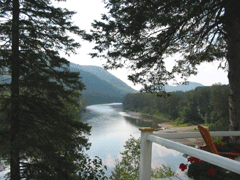
The Grand Cascapedia River (Courtesy of Bob Carty)
CURWOOD: It’s Living on Earth. I’m Steve Curwood. Every summer, a small group of anglers pay a lot of money – around ten thousand dollars a week - to cast a line into a river on the Atlantic coast of Canada. They do it because the Grand Cascapedia has produced three quarters of the largest Atlantic salmon ever caught in North America.
And not only that – the Cascapedia’s salmon stocks are in good shape while many salmon rivers in eastern Canada are in decline and most in the eastern United States are barren. A key reason for that lies in the Cascapedia’s fabled history, the subject of a recent book by Hoagy Bix Carmichael. He’s the son of the great singer-songwriter, Hoagy Carmichael who gave us “Georgia on My Mind” and “Stardust.”
Producer Bob Carty spent some time fishing with Hoagy Bix Carmichael – talking about history and his father’s music, and about the river he loves.
[MUSIC: The Mills Brothers “Up a Lazy River” from ‘The Mills Brothers’]
CARMICHAEL: There are a number of rivers mentioned in Dad’s songs. This one is not a lazy, this river can be a torrent in fact, not “up a lazy river.” I wish Dad had been a fisherman – it would have been something that we could have shared together.
CARTY: Wherever Hoagy Bix Carmichael goes, his father, and his father’s music are never far away, even when he’s standing on slippery rocks, waist deep in the fast-moving waters of the Grand Cascapedia River. Hoagy swings his 11-foot pole back and forth, looping the line in broad arcs until it casts a fly 30 yards out across the rapids. The river takes it downstream, and Hoagy watches with the intensity of a sprinter waiting for the starter’s gun.
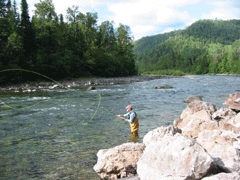
Hoagy casting off.(Courtesy of Bob Carty)
CARTY: The Grand Cascapedia River tumbles out of the remnants of the Appalachian mountain chain in the Gaspe peninsula of Quebec. Its pristine waters cascade down 100 miles of rapids, cutting a narrow valley through dense pine forests. Along the way, in more than 150 pools, there are salmon. From the riverbank you can actually see them - 20 and 30 pounders – floating there on the bottom. Hoagy’s fishing guide, Lee Forn, can’t help but remember what can happen when a fly touches water.
FORN: It was about 20 min before dark, the water just exploded. Had him on for over 2 hours, 60 inches long, 28 inch girth on him – monster fish.
CARTY: But for now, the monster fish are just ignoring Hoagy’s fly. But that’s OK.
CARMICHAEL: A friend of mine said “let me find a good fish and if I do I’ll get a thousand dreams out of it.
CARTY: Hoagy has spent five years of his life writing about this river, not just because of its fish, but because in a way, the river helped save his life.
[MUSIC: Louis Armstrong “Stardust” from ‘Louis Armstrong: Smithsonian Box Set Collection’]
CARTY: Hoagy Bix Carmichael was born in 1938 in Los Angeles and grew up there in the years when his father was at the top of his career – composing hit tunes, starring in Hollywood movies, hosting radio programs, touring around the nation and the world.
As a kid he used to cast plugs into the backyard swimming pool and pretend to catch a big trout. As an adult he found a calling in public television – producing the Mr. Rogers and Julia Childs shows. He was also managing his father’s song catalogue – which meant getting royalties for every new recording of Georgia On my Mind or The Nearness of You. And that allowed him to enjoy his favorite river.
CARMICHAEL: I first came to the Grand Cascapedia in 1985 – I loved the beauty of the river, seeing a bald eagle land as I was casting for a rising 20 lb salmon that you fight for half-an-hour. It really did feel I needed to come back here.
[MUSIC: The Four Aces “Heart and Soul” from ‘The Best of The Four Aces’]
CARTY: And Hoagy Bix did come back here, almost every summer. Even the worst summer of his life. In 1999, Hoagy was diagnosed with a bad case of lymphoma. He had to have chemotherapy. His appendix burst. He was very ill. And it was just a week before he was due to go to the Cascapedia.
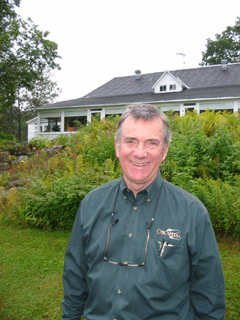
Hoagy B. Carmichael (Courtesy of Bob Carty)
[MUSIC : Hoagy Carmichael “Rockin’ Chair” from ‘Hoagy Sings Carmichael’]
CARTY: Hoagy’s father had always told him that if you look at a piano; there all kinds of new songs waiting there right on the keys … you just have to find them. And so Hoagy began to try to track down the details of the Grand Cascapedia’s history. In the 1880’s, the river was the near exclusive domain of the governors-general of Canada, the representatives of the British Queen. But in 1893, a group of American entrepreneurs bought them out. The best salmon river in the world was turned over to an elite club of American anglers.
[DOOR SLAMS]
CARMICHAEL: This is the original room of the old Cascapedia members - it was a small club of six to eight men at any one time: Mr. Vanderbilt – maybe the richest man in America, Henry Clay Frick, who worked with Andrew Carnegie and developed U.S. Steel. R.G. Dunn, Dunn & Bradstreet, still bears his name – in fact R.G. Dunn employed four of the presidents of the United States, including Abraham Lincoln. And they all brought man servants, some brought two – it’s sort of all the simplicity money can buy.
CARTY: American domination of fishing on the Grand Cascapedia would continue for the next 90 years. Raising not a little amount of debate. The Micmac native people had used these territories, and fished the salmon, for centuries before the sportsmen arrived. John Martin is the local Micmac chief.
MARTIN: I remember speaking with an elder a few years back and I said “Yeah, you must have been doing a lot of fishing in your time when you were a young fellah” and he said, “No, we couldn’t fish, we’d get thrown in jail, we’d get chased off the river. They wouldn’t allow us to fish. And yet, it was our God given right to do so. Guards and gates set up and we were prevented from exercising our rights.
CARTY: But there was an upside to private ownership of fishing rights. It meant there were few anglers and those anglers had a self-interest in preserving the salmon stocks. Over the years they limited the number of rods that could be used at any one time, and the number of fish caught on any one day. They used their political connections to oppose plans to build dams on the river.
CARMICHAEL: That would have made this river a lake – and salmon don’t like lakes – and they would never have gotten up and it would have been dead. They worked very hard and made a few key phone calls – and the proposal was stopped. You quite often find that if you own something you tend not to let it run down – it’s your preserve. They’ve always been able to limit the amount of fishing that’s been on this river.
CARTY: That’s a view shared by many locals. Mary Robertson was born and raised in the valley, and now she’s the director of the Grand Cascapedia Museum.
ROBERTSON: I heard a wonderful quote and it was a gentleman from this area and he said, “If it had not been for the Americans on this river, there would not be a salmon left in the river.” These people came into this river, it became let’s say their playground, so they knew they had to protect their resource. Whey you look at this situation from the outside you’re saying “Oh yes what is it, the Americans came in and they had the rights to the river and we the local people can’t fish. But some of the local people were able to make a bit of money. They worked for them, carpentry skills were used. The women were able to work in the camps and to this day, that continues. There’s a close bond between the people who have the camps, and the local people.
[MUSIC: Hoagy Carmichael “Some Days There Just Ain’t No Fish” from ‘Buttermilk Sky’]
CARMICHAEL: Some days there just ain’t no fish – other days there might be – and that’s what keeps the fisherman alive – you think you’re gonna catch something. You’re just sure of it.
[MUSIC: Hoagy Carmichael “Some Days There Just Ain’t No Fish” from ‘Buttermilk Sky’]
CARMICHAEL: We’re in the room right now, the bedroom that Jimmy and Roslyn Carter stayed in when they came fishing here. That’s Bing Crosby, a picture of Mr. Crosby up here.
CARTY: Over the years, more and more celebrities have come to the Grand Cascapedia. But the river is no longer run as a private club. In the late 1970’s, the provincial government of Quebec kicked out a lot of foreign fishing clubs and set up government agencies to run the rivers. It was an egalitarian idea – offering easy and relatively cheap access to salmon fishing for everyone. But many of those rivers have been over-fished.

The Grand Cascapedia River (Courtesy of Bob Carty)
One thing they decided was that to protect the resource, fishing would be kept expensive. Through a lottery, some lucky members of the public can have access to fishing pools for as little as $60 a day. For most anglers it’s a bit more costly.
CARMICHAEL: For a day for two people it’s somewhere in the area of 1300-1400 dollars. When you think about it, eight or nine hours fishing on a river that could bring you the biggest fish of your life, or the biggest fish in Canada, it’s not too bad.
CARTY: The sports fishery on the Cascapedia supports about 130 jobs in the valley. It brings in more than four million dollars a year – and given that about a thousand fish are caught each year, that means that each fish caught on the fly is worth four thousand dollars.
CARMICHAEL: Lee Wolfe, the great angling writer and fisherman, said, a salmon is too valuable to only catch once. He’s right about that.
CARTY: Which is why the Cascapedia Society supports “catch and release”. Hoagy hasn’t killed a salmon in eight years. You can get a license to take a salmon away to your dinner table. But 87% of the salmon landed on the Cascapedia are now set free. And that has increased the average weight of the fish to about 20 pounds.
Meanwhile, a deal with Greenland’s commercial fish operators has got them fishing for anything but salmon, and that is helping stocks return to a number of rivers, including the Grand Cascapedia. The result: back in the 1950’s there were only 250 large salmon in this river. This year biologists counted 2,700. That’s double the number in all rivers in the U.S. Northeast. Yet, there still are serious concerns for the future.
[MUSIC : Geoff Muldaur & Amos Garrett “Washboard Blues” from ‘Washboard Blues’ (Vivid Sound)]
CARMICHAEL: The greatest threat to this river and all rivers is global warming of course because we have weather patterns and warmer water that will affect this river in 30 or 40 or 50 years and that scares me a lot. It’s fragile, it’s on the edge of being fragile.
[TRUCK GOES BY]
CARMICHAEL: There is a road running along here, used by tourists, fishermen, and a lot of logging trucks.
CARTY: Living with the logging industry is a huge challenge for this river. A few years ago local residents, natives and anglers pressured the forestry companies to reduce the amount of silt run-off. But clear-cutting in the watershed creates a long-term problem, a problem Cascapedia Society manager Marc Gauthier explains to me as we take a canoe ride up the river.
[POLLING UP RIVER]
[FISH JUMPS]
GAUTHIER: “Look at that. That’s a big fish. They jump out of the water. That’s Salmo Salar, that’s the latin name. Salar meaning, “the leaper”. The river is aging. We’re getting flash floods. The logging industry tells us we have as much water as before, but that water passes by in three days instead of giving us water throughout the season. The flash floods erode the bank. You get wider river and shallower. We’re losing pools on yearly basis. So we have to control logging so it doesn’t interfere with aquatic wildlife.
[RIVER BABBLE]
CARMICHAEL: Lady Amherst, that’s a D-fly, what’s called a stone fly. Double hook gives you a little more weight.
CARTY: Back in his fishing pool, Hoagy is going through his fly wallet. Maybe a change will bring a bite. If it does he’ll land the fish, give it a pat and let it go.
CARMICHAEL: There is a sense of conservation here where you are not trying to pound these fish to death. You fish and you go home. It does work.
CARTY: For Living on Earth. I’m Bob Carty on the Grand Cascapedia River in the Gaspe of Quebec.
[MUSIC: Hoagy Carmichael “Lazy River” from ‘The Classic Hoagy Carmichael’ (CBS Records)]
CURWOOD: To find out more about the Cascapedia River, go to our website, www.loe.org, where you can hear our program anytime.
[MUSIC: Hoagy Carmichael “Lazy River” from ‘The Classic Hoagy Carmichael’ (CBS Records)]
Related links:
- Hoagy B. Carmichael’s book “The Grand Cascapedia River: A History, Volume One”
- The Cascapedia River Museum
CURWOOD: Next week on Living on Earth, an historical mill town is set for a makeover, and one developer plans to make this relic of the industrial revolution a prototype for the green revolution.
ANSIN: We decided if we’re going to bring this building back, let’s bring it back in a way that minimizes the impact on the environment, and let’s respond to the people who are coming here to buy t condos. These are people who grew up in the 60s and 70s who want to live their ideals.
CURWOOD: The renewable revival of Lawrence, Massachusetts, next time on Living on Earth.
[BALD EAGLE SOUNDS]
CURWOOD: We leave you this week with the a fisher who doesn’t practice catch-and-release.
[BALD EAGLE SOUNDS]
|
|
CURWOOD: The bald eagle was declared the official emblem of the United States in 1782. The raptor was listed as endangered in the lower 48 states in the late 1970’s but has since made a remarkable comeback due to the ban on DDT, as well as protections under the Endangered Species Act. Bernie Krause recorded this fledgling bald eagle learning to fish for salmon near Glacier Bay in Alaska.
[BALD EAGLE SOUNDS]
Living on Earth is produced by the World Media Foundation. Our crew includes Ashley Ahearn, Eileen Bolinsky, Bruce Gellerman, Ian Gray, Ingrid Lobet, Andrea Smardon, and Jeff Young - with help from Bobby Bascomb, Kelley Cronin, and Jeff Turton. Our interns are Lauren Cox and Amy Fish.
Dennis Foley is our technical director. Alison Lirish Dean composed our themes. You can find us anytime at LOE dot org. I’m Steve Curwood, from all of us at Living on Earth, thank you for listening.
ANNOUNCER: Funding for Living on Earth comes from the National Science Foundation, supporting coverage of emerging science; And Stonyfield Farm Organic yogurt, smoothies and milk. Stonyfield pays its farmers not to use artificial growth hormones on their cows. Details at Stonyfield dot com.
Support also comes from you our listeners, the Ford Foundation, the Wellborn Ecology Fund, and Pax World Mutual Funds—socially and environmentally sustainable investing. Pax World, for tomorrow. On the Web at paxworld dot com.
Living on Earth wants to hear from you!
Living on Earth
62 Calef Highway, Suite 212
Lee, NH 03861
Telephone: 617-287-4121
E-mail: comments@loe.org
Newsletter [Click here]
Donate to Living on Earth!
Living on Earth is an independent media program and relies entirely on contributions from listeners and institutions supporting public service. Please donate now to preserve an independent environmental voice.
NewsletterLiving on Earth offers a weekly delivery of the show's rundown to your mailbox. Sign up for our newsletter today!
 Sailors For The Sea: Be the change you want to sea.
Sailors For The Sea: Be the change you want to sea.
 The Grantham Foundation for the Protection of the Environment: Committed to protecting and improving the health of the global environment.
The Grantham Foundation for the Protection of the Environment: Committed to protecting and improving the health of the global environment.
 Contribute to Living on Earth and receive, as our gift to you, an archival print of one of Mark Seth Lender's extraordinary wildlife photographs. Follow the link to see Mark's current collection of photographs.
Contribute to Living on Earth and receive, as our gift to you, an archival print of one of Mark Seth Lender's extraordinary wildlife photographs. Follow the link to see Mark's current collection of photographs.
 Buy a signed copy of Mark Seth Lender's book Smeagull the Seagull & support Living on Earth
Buy a signed copy of Mark Seth Lender's book Smeagull the Seagull & support Living on Earth


